Menu
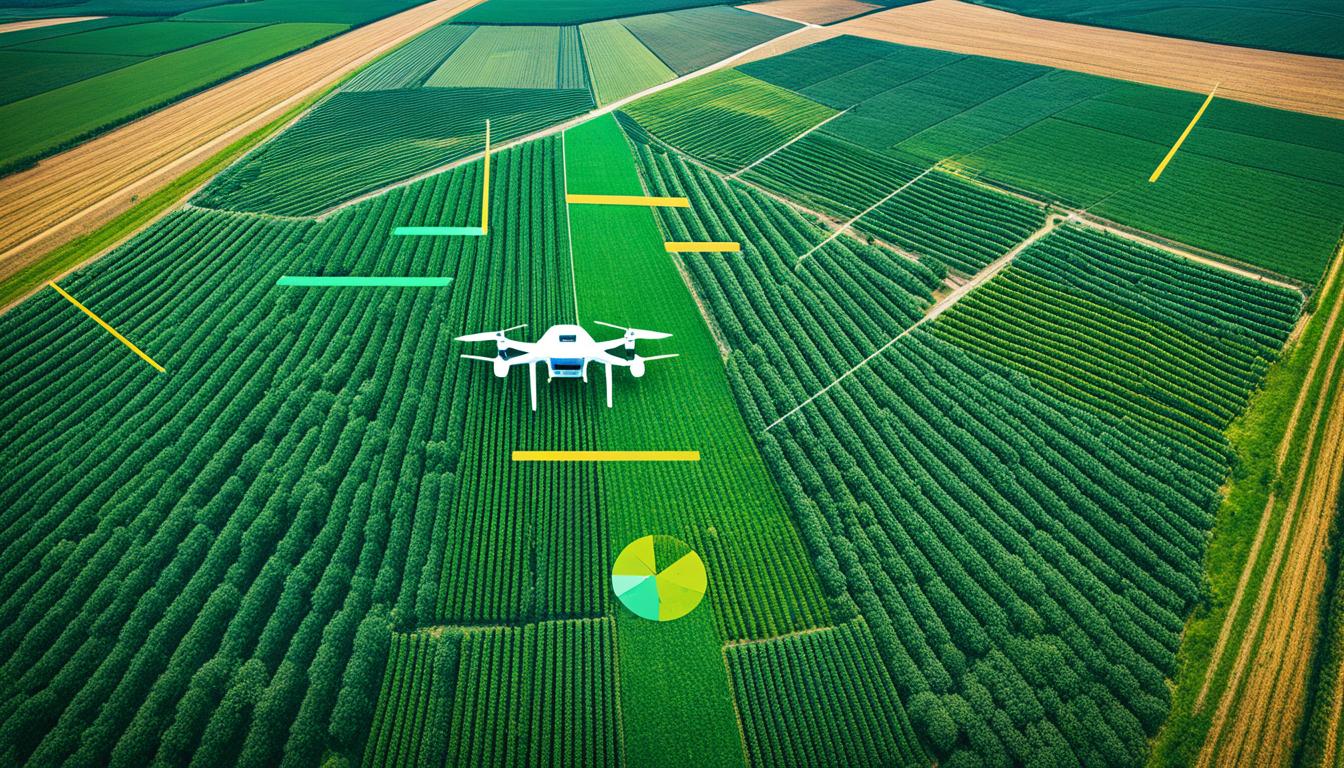
Did you realize the global population could hit 10 billion by 2050? This will put more pressure on farming to produce more food. But, we face challenges like limited land, less labour, and the effects of climate change. This is where AI and machine learning come into play, offering innovative solutions.
Intellias, a leader in agtech, shows us how AI is changing farming. With over 20 years in the field, they prove AI is more than a dream; it’s a game-changer. AI makes farming smarter, helping to predict markets, save resources, and cut costs. As Farmer Patsy says, “It’s how we will feed the future, sustainably.”
Today, we already see the benefits of automation with self-driving tractors and smart watering systems. AI also helps monitor crops, soil, and detects pests more accurately. With these advancements, farming is becoming more efficient, promising higher yields and better practices.
AI and machine learning are modernising agriculture. They tackle global issues like climate change and limited resources. By analysing data and giving insights, they help farmers make better decisions. This changes how farming works towards more sustainable food systems.
There are also smart systems like agriculture ERPs, made by companies like Folio3. These handle planning, resources, and money, making work easier and more productive2. Farmer Patsy says using these techs is key to meeting farming’s modern challenges. They ensure the future of farming is both sustainable and profitable.
In today’s world, AI helps predict what the market will need and when to farm. This is key in managing farms well. It makes farming more exact and data-focused. These changes make farming smarter and more efficient.
With the world’s population heading towards 10 billion, ensuring food security is critical. The need to produce food on our current farmland is more important than before. We must turn to advanced farming technology to boost our output.
The world’s growing population means we need more food than ever. This demand is pushing traditional farming to its limit. Future farming methods, like vertical farms, use much less water. They are a smart way to satisfy our food needs efficiently4. Advancements in precision agriculture are also making big waves. The market is set to hit $43.4 billion by 20254. Farmer Patsy argues that we must adopt these new technologies to stay productive and sustainable.
Deforestation, soil erosion, and water scarcity are big hurdles for sustainable farming. Thanks to technology, we’ve seen improvements. Automated irrigation cuts down on water waste. It also helps farmers adjust to the weather better5. Genetically modified crops are another success story. They’ve cut down on pesticides and increased yields. As a result, farming is becoming more sustainable. This trend is vital for protecting our environment.
Traditional farming isn’t keeping up with today’s demands and environmental issues. But, modern greenhouses are changing the game. They use advanced technology like LED lights and climate control. This boosts what we can grow. The blockchain system makes farming data more secure and shareable4. This transition shows just how important technology is for efficient and sustainable farming.
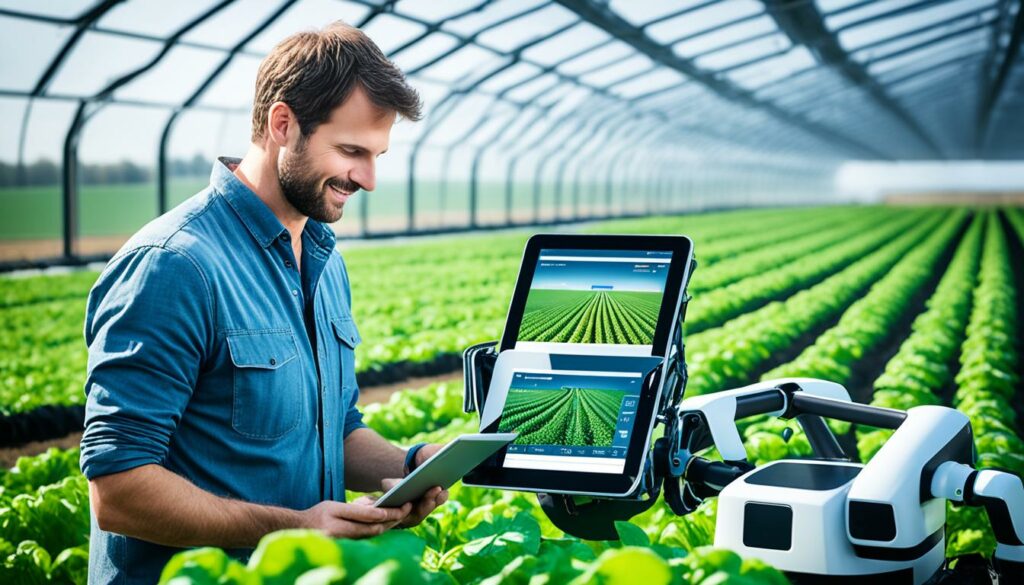
As we add more AI and tech to farming, we’re preparing to feed the future. Automated systems, better farming precision, and advanced irrigation methods are crucial. They help us reach a sustainable food system. By always looking for new solutions, we can keep the food supply stable.
In agriculture, AI data analysis is key to making smart decisions. It uses huge amounts of data and updates in real time. This helps farmers manage their farms better, by offering insights into what crops to grow and the condition of the soil. It’s all about making farming smarter and more efficient.
Predictive analytics is changing farming as we know it. It gives precise guesses on how much crops will grow and when. Yield mapping with AI lets farmers see where they could improve and act fast. This means better plans for the farm and more crops.1 Farmer Patsy says, “Predictive analytics has fundamentally changed how we plan our cultivation cycles, leading to healthier crops and better yields.”
AI also helps in figuring out what the market wants and how prices might change6. By using data, farmers can better meet these demands and make more money. They look at past and present data to stay on top of the market. This way, they can adjust their plans to match the market’s needs.
AI shines in figuring out the best times to plant and harvest. With the world’s population set to hit 10 billion by 2050, it’s more important than ever to get the most out of our crops1. AI looks at the weather, soil, and crop stages to help farmers make the best decisions6. This leads to more efficient farming and supports the use of sustainable methods.
AI and machine learning are making a big difference in farming. They help us save money. This is changing how we use our resources and improve our work.
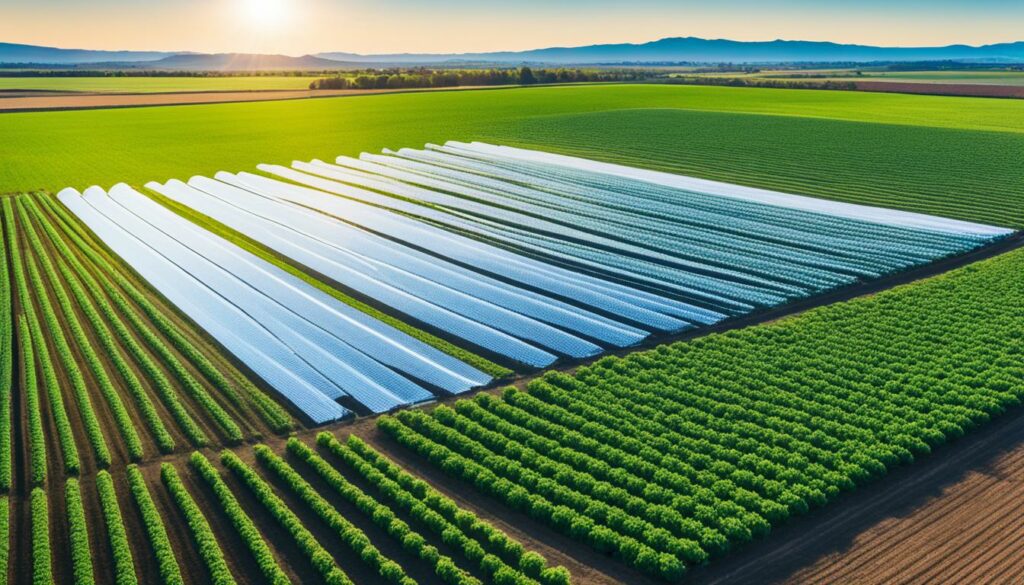
AI makes farming better by carefully planning resource use. It predicts what crops need and helps manage things like water and fertiliser. For example, AI drones are smart at putting down pesticides. They use just what’s needed1. This means less harm to the environment and savings for farmers.
When we use AI well, we make more money. It helps us grow crops better. For example, for key crops, AI has cut costs by 26 to 31% per acre7. These savings mean more profit in the long run for farmers.
The world of farming is changing fast with new technologies. Today, farms use machines that don’t need a driver, smart systems for watering and feeding plants, and greenhouses controlled by AI. These tools make farming more efficient and accurate than before.
Autonomous tractors are leading this change. They work without a human driver, doing tasks quicker and more precisely than people can9. They also help cut down on the cost of hiring workers, a big problem for many farms10. Farmer Patsy wisely points out, “By using driverless tech, we can make sure our farms keep growing for years to come.”
At the cutting edge are the AI-managed greenhouses. They control the climate for plants to thrive11. Thanks to detailed monitoring and smart analysis, AI adjusts temperature, moisture, and light. This means more and better crops can be produced with fewer inputs9. It’s a prime example of how tech can boost efficiency and save resources in farming indoors.
These advances show the path farming is taking. The future is all about using smart machines for more effective and eco-friendly farming.
As a farmer at Countrywide Farmers, I’ve seen smart irrigation tech change how we farm. This AI-based tech can use up to 50% less water than old ways, which is great for our planet12. Sure, at the start, it costs a bit more because of all the sensors. But it pays off big time, making our plants healthier and stopping our soil from washing away12.
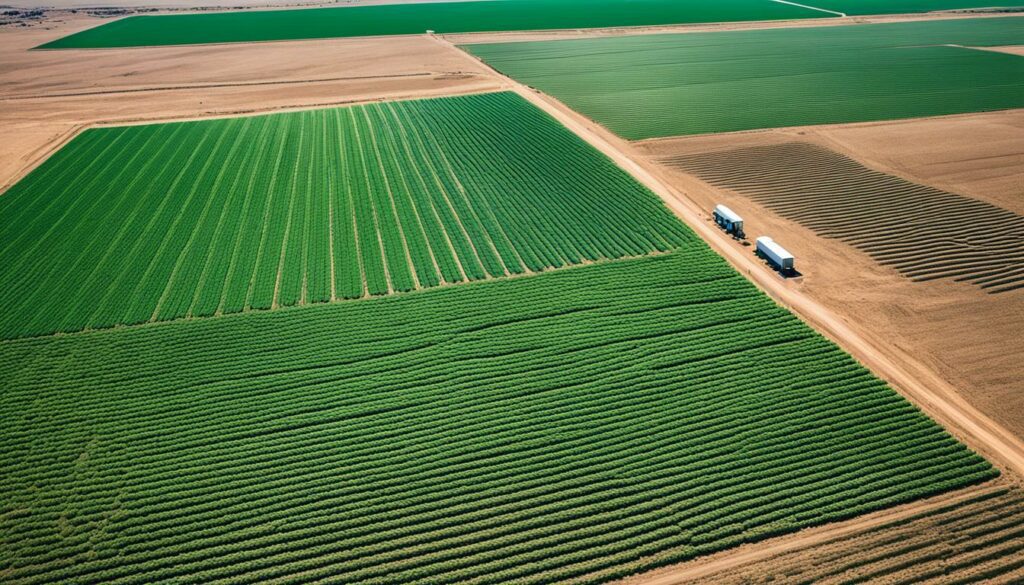
Another big plus is less water runoff and fewer chemicals in our soil14. This is better for the environment and means we farm in a way that keeps going for the future. Dr. Guzmán is working hard to make this tech easy for everyone to use13. As a farmer, I’ve seen how smart irrigation has made my work both more efficient and friendly to our earth.
Using smart irrigation is a smart move for any farmer wanting to save water and farm sustainably. It’s not just about saving money. It’s about improving how we farm in every way.
“Smart irrigation technology represents the future of farming by harmonising water use with crop requirements, making sustainable water management a reality,” says Farmer Patsy.
AI is changing how we approach farming for the better. It helps farmers grow their crops more efficiently. This is done by using smart soil monitoring and analysing crop health. AI ensures that crops are looked after well, leading to better harvests.
AI provides key info on soil, including its water and nutrient levels. It watches over how wheat grows and how ripe tomatoes and other crops are
. AI does this with more accuracy than humans, hitting a 99.31% correct rate. This gives farmers precise details about their soil without expensive lab tests15. It also suggests the best time and amount to use fertiliser and pesticides, thanks to knowing what the soil and weather are like right then1.AI makes sure crops get just the right amount of water and nutrients. It looks at big sets of data to find out what each plant type needs. This way, farmers can use water better and maybe save up to 50 billion gallons a year15. These tricks help farming be kinder to the planet and might be key in feeding more people well by 2050115.
“AI has paired soil monitoring and crop health checks, changing farming for the better. With better timing and use of resources, we’re getting more crops and doing it more sustainably,” shares Farmer Patsy.
Precision agriculture combines the latest tech with detailed data analysis. It aims to improve farming in a smart, cost-effective, and eco-friendly way16. This approach transforms farming with AI. It uses tools like soil sensors to manage crops better. These tools check the soil’s health and give crops what they need, boosting the harvest16.
The precision farming market has boomed, hitting USD 9.4 billion in 2022. Experts predict it will grow by 12.6% yearly until 203017. Places like North America and Europe are quick to adopt these new methods. Yet, even in developing areas, such technologies are catching on17. The use of AI is essential worldwide for better yields and smarter crop care.
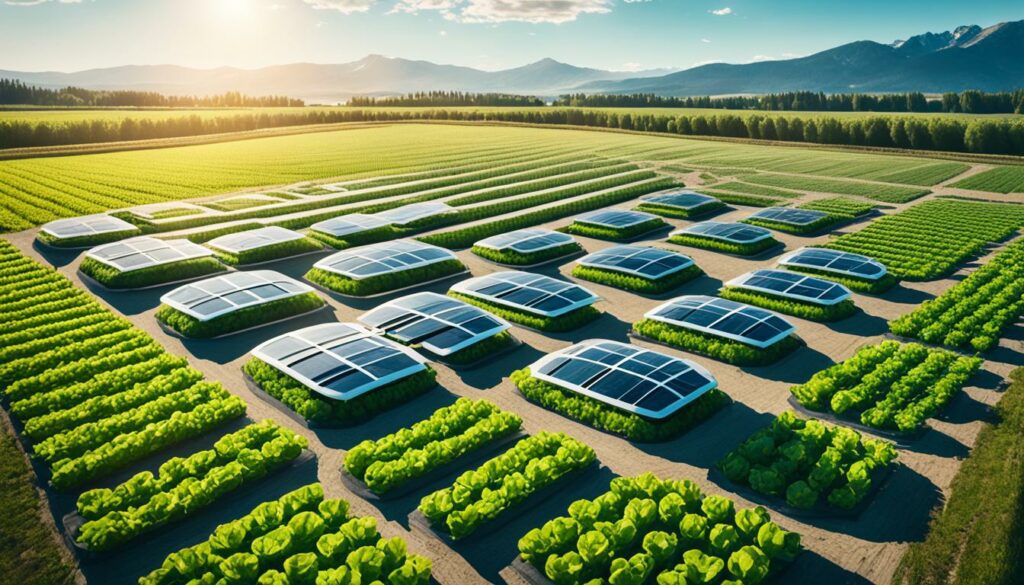
Patsy, a farmer who knows a lot about these technologies, says,
“AI in precision farming is key for higher yields and eco-friendly practices. It helps us see future farming trends and use our resources better.”
To sum up, mixing high-tech tools with farming is all about getting better harvests. From machines that follow GPS to smart gadgets, the aim is clear: to farm in a way that’s profitable and kind to the planet18.
Drones have changed how farmers keep an eye on their crops. They use these flying machines to map fields with great detail. This is much better than how they did it before.
Drones, including their cameras and sensors, are key in keeping crops healthy19. They show farmers what the soil and plants need. This helps farmers take quick action to make their crops grow better19. With special cameras, drones can even spot problems before they get too big. This cuts down on bad surprises and saves farmers money19.
Farmer Patsy says, “Drones bring loads of data that helps us farm smarter. This kind of farming boosts the amount of food we can grow per field.”
In Brazil, drones did a great job at finding where weeds were. By doing this, they helped cut down on weed-killing chemicals by 52% in some soybean fields20. This is better for both the environment and a farmer’s wallet.
Drones are also handy for treating fields exactly where they are needed. They use information from above to spray water, fertilisers, and bug killers in only the right spots19. This saves on chemicals and makes sure crops get the exact care they need. It also helps more plants and animals live together happily19.
| Feature | Traditional Methods | Drone Technology |
|---|---|---|
| Environmental Impact | High | Low |
| Herbicide Use | High | Reduced by 52%20 |
| Data Accuracy | Moderate | High |
| Cost Efficiency | Variable | Improved |
AI is changing how we fight pests and diseases in farming, making solutions quick and accurate. As a farm expert, I’ve seen AI boost crop health and yield greatly.
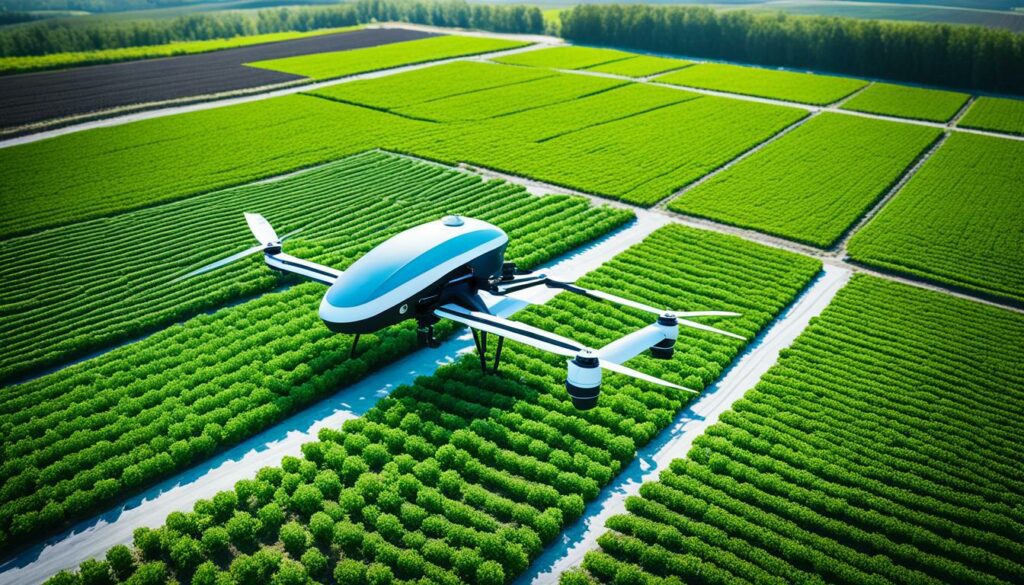
AI systems spot pests and diseases early, sometimes before we see any signs. This early warning lets farmers act fast and save their crops22. AI looks at a lot of data to find the exact problem and how bad it is. This helps cut down on pesticides and saves resources22. I believe this quick action is key, especially for top-quality crops.
AI keeps an eye on fields in real-time with cameras and sensors. It gives constant updates to help farmers act against threats right away22. With up to 40% of the world’s crops lost to pests each year, this tech is a must23. Plus, experts say these pest attacks will go up 36% by 2050, highlighting AI’s importance23.
Me and many other farmers trust these technologies for good watch. Companies like Farmsense are leading the way, getting big funds for better AI23.
Automated AI tools cut down on work costs and improve crop quality and yield24. For example, Doctor Nabat app is at the frontier, looking through 25,000 disease and deficiency images. It makes plant disease diagnosis very precise23. The process is clear, starting from taking pictures to accurate disease checks24.
This tech boom leads to *hands-off pest management*, an area where AI shines by using fewer chemicals and saving crops and nature22. As I often mention, “Putting money into AI tools is putting money into farming’s future.” This is so true for fighting pests and diseases.
Integrating AI in animal husbandry is changing how we look after livestock. It boosts efficiency and productivity in monitoring their health. With AI, we can keep track of their conditions and behaviours more closely. We can spot health issues early, and make sure they get the right food and living conditions.
AI helps farmers watch over their animals’ health and actions with great detail. It uses advanced tools to constantly observe the animals. It quickly picks up on any problems, letting farmers act fast to keep the animals healthy. This method is key to making sure the animals are well and working at their best.
Using AI for spotting diseases early is very important for livestock. It can see signs of sickness before they get too serious. This reduces the chance of diseases spreading wide. By using AI, farmers can stop health threats early. This helps keep the animals healthy and the farm running smoothly.
AI is also vital in finding the best diet and living conditions for animals. It looks at what they need to eat and their surroundings. This makes sure animals get the perfect food and place to live. It boosts how well they do and the farm’s overall success.
As Farmer Patsy at Countrywide Farmers, I’ve seen AI make big improvements. I’m sure AI is the path to better farming, making it smarter and more sustainable. You can learn more about how AI affects agriculture by visiting AI in Agriculture.
Smart greenhouses are changing agriculture using IoT and AI. These technologies get environmental data in real-time for precision farming. I, Farmer Patsy, have seen how they make farming sustainable and more productive25.
They watch over the temperature, air quality, sunlight, and more in these greenhouses. This keeps the plants healthy. With IoT, farmers get alerts on their phones about any problems in the greenhouse. They can then act quickly to avoid issues like infections25.
Devices and automation in smart greenhouses help plants grow better by controlling the climate and soil. These high-tech farms offer many benefits. They help with creating the perfect conditions for various crops and stop thefts25. This technology mix, AI and IoT, changes farming for the better and more sustainably, I’m sure of it as a specialist25.
AI uses data to predict market demands and find the best times for planting and harvesting. This helps farmers make better choices, improving their farming efficiency.
Integrating AI and machine learning leads to precision in farming and better use of resources. It cuts down on costs, increases profits, and boosts crop growth. These technologies also bring automation and smart irrigation to farms for improved management.
AI is key in promoting eco-friendly farm practices. It manages water sustainably, reduces the need for harmful chemicals, and keeps the soil healthy. AI also uses data to help predict and combat the effects of climate change.
Driverless tractors automate farm work, cutting back on human effort. Using AI, they work independently and precisely, making farming more efficient and reliable.
With AI, smart systems keep an eye on water and nutrient levels, making real-time adjustments. They prevent waste and stick to eco-friendly farming.
AI monitoring gives deep insights into soil and crop health. This information helps in using fertilisers and pesticides more efficiently to boost crop health and yield.
AI boosts precision farming by ensuring water and nutrients are used effectively. It helps in targeting pests accurately and keeping a close eye on crop health, leading to better yields.
Drones offer real-time data on crops and can apply treatments with precision. This fine-tunes farming practices and improves efficiency.
AI spots diseases and pest threats early, offering automated control options. This quick response helps protect crops from harm.
AI in livestock care includes health checks, disease early warning, and better diet management. It aims at enhancing animal wellbeing and productivity.
Smart greenhouses use AI to maintain ideal conditions for plants. They regulate climate parameters using data, ensuring the best growth settings.